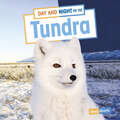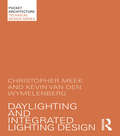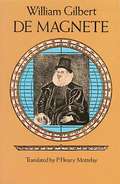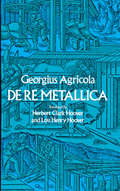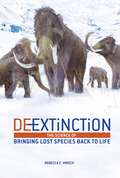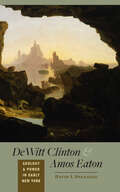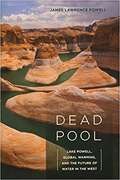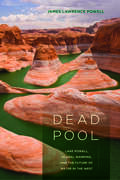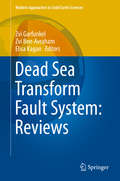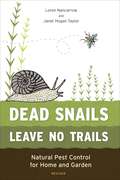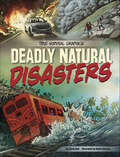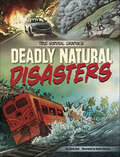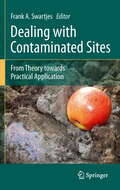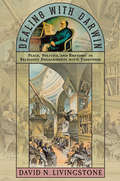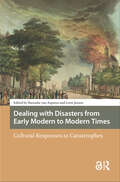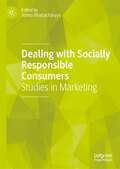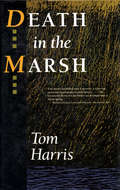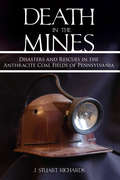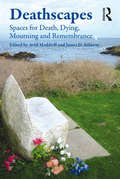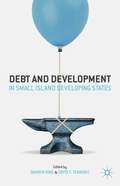- Table View
- List View
Day and Night on the Tundra (Habitat Days and Nights)
by Mary BooneSpend a day and night in the tundra! Learn about this cold habitat through the intriguing animals that call it home. Catch breakfast mid-flight with a peregrine falcon. Spend the afternoon snoozing with an Arctic fox. Take an evening trek with a herd of caribou. After dark, sit still with an Arctic hare as it hides from hungry wolves. What will tomorrow bring in the tundra?
Daylighting and Integrated Lighting Design (PocketArchitecture)
by Christopher Meek Kevin Van WymelenbergDaylighting and Integrated Lighting Design provides architects, building designers, and students clear direction for the successful inclusion of daylight and integrated electric light in buildings. It presents design teams with the performance analysis resources, energy saving estimates and user satisfaction results they need in order to make informed decisions regarding daylighting and lighting design. Written by two well-known experts in the field, the book provides: critical geometric and material relationships along with proven design process activities, offered in a quick-reference format, with sufficient context to address the range of associated issues present in any building project both the "fundamentals" and "applications" which cover design concepts and practice activities applicable to all integrated lighting projects specific directives for how the concepts covered are applied in a range of common design scenarios, including architectural rules-of-thumb, instructions for ensuring visual comfort, and preferred approaches for electric lighting control integration. In demonstrating these necessary insights to designers, the authors employ an iterative analysis of common "daylighting patterns" and illustrate and annotate both successful and unsuccessful examples via built form and simulation. Part of the PocketArchitecture series, this is the ideal pocketbook for any designer serious about reducing the energy impact of their buildings.
Dayside Magnetosphere Interactions (Geophysical Monograph Series #249)
by Hui Zhang Philippe Escoubet David Sibeck Guan Le Qiugang ZongExploring the processes and phenomena of Earth’s dayside magnetosphere Energy and momentum transfer, initially taking place at the dayside magnetopause, is responsible for a variety of phenomenon that we can measure on the ground. Data obtained from observations of Earth’s dayside magnetosphere increases our knowledge of the processes by which solar wind mass, momentum, and energy enter the magnetosphere. Dayside Magnetosphere Interactions outlines the physics and processes of dayside magnetospheric phenomena, the role of solar wind in generating ultra-low frequency waves, and solar wind-magnetosphere-ionosphere coupling. Volume highlights include: Phenomena across different temporal and spatial scales Discussions on dayside aurora, plume dynamics, and related dayside reconnection Results from spacecraft observations, ground-based observations, and simulations Discoveries from the Magnetospheric Multiscale Mission and Van Allen Probes era Exploration of foreshock, bow shock, magnetosheath, magnetopause, and cusps Examination of similar processes occurring around other planets The American Geophysical Union promotes discovery in Earth and space science for the benefit of humanity. Its publications disseminate scientific knowledge and provide resources for researchers, students, and professionals.
De Magnete
by William GilbertMuch of modern science is based upon the theories and discoveries of William Gilbert, the brilliant English physician and physicist who was the first great experimental scientist. Gilbert was the first to use the word "electricity," to recognize mass as distinct from weight, to discover the effect of heat upon magnetic bodies, to differentiate clearly between static electricity and magnetism, and to explain phenomena of terrestrial magnetism in terms of the earth as a giant magnet.In 1600 he published De Magnete in Latin. As lively and entertaining as it was scientifically scrupulous, it summarized everything that had previously been known about electricity and magnetism, founded a new science and earned Gilbert the title of "the father of modern electricity." In it Gilbert explores magnetism and electricity, lodestones, phenomena of magnetism, direction of the earth's magnetic lines of force, variation in the compass, dip, the concept of the earth as a giant magnet, and much else.This Dover edition is a complete, unabridged reprinting of the definitive English translation of De Magnete prepared by Dr. P. Fleury Mottelay. Dr. Mottelay has added a number of footnotes that explain points that might be obscure to today's readers, who will find in this historically important text invaluable insights into the origins of modern science and physics. Translation by P. F. Mottelay. Biographical introduction. 90 illustrations.
De Natura Fossilium (Dover Earth Science)
by Georgius AgricolaThis 1546 publication remains a landmark in geology due to its unprecedented classifications by physical property and locality, its simple standardized naming system, its meticulous summaries of earlier studies, and its employment of observation and personal experience.
De Re Metallica: De Re Metallica. Libri Xii. . . (Dover Earth Science)
by Georgius AgricolaOriginally published in 1556, Agricola's De ReM etallica was the first book on mining to be based on field research and observation — what today would be called the "scientific approach." It was therefore the first book to offer detailed technical drawings to illustrate the various specialized techniques of the many branches of mining, and the first to provide a realistic history of mining from antiquity to the mid-sixteenth century. For almost 200 years, Agricola remained the only authoritative work in this area and by modern times it had become one of the most highly respected scientific classics of all time. A book more often referred to in literature on mining and metallurgy than any other, its Latin text prevented it from being as widely used as it might have been. <p><p> In 1912, the book was translated by former President Herbert Clark Hoover and his wife. Printed in a limited edition, the work was quickly bought up by book collectors, historians, and medievalists, who had found that there was much to be learned from its pages. The book contains an unprecedented wealth of material on alluvial mining, alchemy, silver refining, smelting, surveying, timbering, nitric acid making, and hundreds of other phases of the medieval art of metallurgy. The text even covers the legal aspects of mining the use of boundary stones, forfeitures of titles, safety requirements of tunnel building in the 1500s, and so on. <p> But the plates, perhaps more than anything else, have insured Agricola's continued importance. Brilliantly executed drawings, richly detailed, reveal a whole medieval world of machinery, industrial technique, tools, even costume and architecture. All 289 of the original woodcuts are reproduced in this reprint of the 1912 edition, offering students of the period, commercial artists, engineers, metallurgists, and even curious general readers an unforgettable picture of the first age of technology.
De-Centering Sexualities (Critical Geographies)
by Richard Phillips Diane Watt David ShuttletonThis book of critical rural geography breaks new ground by drawing attention to sex and sexualities outside the metropolis. It explores sexualities and sexual experiences in a variety of rural and marginal spaces with international contributions from a wide range of disciplines. These include: literary and cultural studies, lesbian and gay studies, geography, history and law. Among the topics uncovered are:* a lesbian in rural England* sexual life in rural Wales* sexuality in rural South Africa * scandal in the American South: sex, race and politics* nature and homosexuality in literature* Derry/Londonderry as a sexual space* how 'country folk' are sexualised in popular culture.
De-Extinction: The Science of Bringing Lost Species Back to Life
by Rebecca E. HirschIn the twenty-first century, because of climate change and other human activities, many animal species have become extinct, and many others are at risk of extinction. Once they are gone, we cannot bring them back—or can we? With techniques such as cloning, scientists want to reverse extinction and return lost species to the wild. Some scientists want to create clones of recently extinct animals, while others want to make new hybrid animals. Many people are opposed to de-extinction. Some critics say that the work diverts attention from efforts to save species that are endangered. Others say that de-extinction amounts to scientists "playing God." Explore the pros and cons of de-extinction and the cutting-edge science that makes it possible.
DeWitt Clinton and Amos Eaton: Geology and Power in Early New York
by David I. SpanagelHow did geology and politics inform scientific ideas and contribute to New York's prominence in the early nineteenth century?David I. Spanagel explores the origins of American geology and the culture that promoted it in nineteenth-century New York. Focusing on Amos Eaton, the educator and amateur scientist who founded the Rensselaer School, and DeWitt Clinton, the masterful politician who led the movement for the Erie Canal, Spanagel shows how a cluster of assumptions about the peculiar landscape and entrepreneurial spirit of New York came to define the Empire State. In so doing, he sheds light on a particularly innovative and fruitful period of interplay among science, politics, art, and literature in American history.
Dead Heat: Global Justice and Global Warming (Open Media Series)
by Paul Baer Tom AthanasiouToday's "extreme weather events" (record-breaking heat waves, droughts, and melting ice caps) foreshadow an increasingly unstable and dire future. Yet, despite all, the US government continues to reject the Kyoto Protocol, to deny the catastrophic consequences of oil dependency, and to define the politics of oil as the politics of U.S. unilateralism, domination, and war.Dead Heat argues that justice--not rhetoric and "aid" but real developmental justice for the people of developing world--is going to be necessary, and surprisingly soon. It argues, more particularly, that such a justice must involve a phased transition from the Kyoto Protocol to a new climate treaty based on equal human rights to emit greenhouse pollutants. Dead Heat makes the case for climate justice, but insists that justice and equity, for all their manifold ethical and humanitarian attractions, must also be seen as the most "realistic" of virtues. It insists, in other words, that our limited environmental space will itself show that it is the dream of a "business as usual" future that is naïve and utopian.
Dead Pool: Lake Powell, Global Warming, And The Future Of Water In The West
by James Lawrence PowellWhere will the water come from to sustain the great desert cities of Las Vegas, Los Angeles, and Phoenix? In a provocative exploration of the past, present, and future of water in the West, James Lawrence Powell begins at Lake Powell, the vast reservoir that has become an emblem of this story. At present, Lake Powell is less than half full. Bathtub rings ten stories tall encircle its blue water; boat ramps and marinas lie stranded and useless. To refill it would require surplus water―but there is no surplus: burgeoning populations and thirsty crops consume every drop of the Colorado River. Add to this picture the looming effects of global warming and drought, and the scenario becomes bleaker still. Dead Pool, featuring rarely seen historical photographs, explains why America built the dam that made Lake Powell and others like it and then allowed its citizens to become dependent on their benefits, which were always temporary. Writing for a wide audience, Powell shows us exactly why an urgent threat during the first half of the twenty-first century will come not from the rising of the seas but from the falling of the reservoirs.
Dead Pool: Lake Powell, Global Warming, and the Future of Water in the West
by James Lawrence PowellWhere will the water come from to sustain the great desert cities of Las Vegas, Los Angeles, and Phoenix? In a provocative exploration of the past, present, and future of water in the West, James Lawrence Powell begins at Lake Powell, the vast reservoir that has become an emblem of this story. At present, Lake Powell is less than half full. Bathtub rings ten stories tall encircle its blue water; boat ramps and marinas lie stranded and useless. To refill it would require surplus water—but there is no surplus: burgeoning populations and thirsty crops consume every drop of the Colorado River. Add to this picture the looming effects of global warming and drought, and the scenario becomes bleaker still. Dead Pool, featuring rarely seen historical photographs, explains why America built the dam that made Lake Powell and others like it and then allowed its citizens to become dependent on their benefits, which were always temporary. Writing for a wide audience, Powell shows us exactly why an urgent threat during the first half of the twenty-first century will come not from the rising of the seas but from the falling of the reservoirs.
Dead Sea Transform Fault System: Reviews
by Zvi Garfunkel Zvi Ben-Avraham Elisa KaganThe Dead Sea transform is an active plate boundary connecting the Red Sea seafloor spreading system to the Arabian-Eurasian continental collision zone. Its geology and geophysics provide a natural laboratory for investigation of the surficial, crustal and mantle processes occurring along transtensional and transpressional transform fault domains on a lithospheric scale and related to continental breakup. There have been many detailed and disciplinary studies of the Dead Sea transform fault zone during the last 20 years and this book brings them together. This book is an updated comprehensive coverage of the knowledge, based on recent studies of the tectonics, structure, geophysics, volcanism, active tectonics, sedimentology and paleo and modern climate of the Dead Sea transform fault zone. It puts together all this new information and knowledge in a coherent fashion.
Dead Snails Leave No Trails, Revised: Natural Pest Control for Home and Garden
by Loren Nancarrow Janet Hogan TaylorA practical guide to repelling indoor and outdoor pests using organic methods, updated with new information on getting rid of bedbugs and dust mites, plus includes updated online resources. If you've ever had a swarm of fruit flies in your kitchen or a gopher wreaking havoc in your yard, you may have wondered what a conscientious gardener or homeowner can do short of heavy-duty chemical warfare. Dead Snails Leave No Trails is a comprehensive guide to repelling both indoor and outdoor pests using organic methods--it's the perfect DIY solution to eliminate unwelcome visitors in your home and garden while keeping yourself,your family, and the environment safe from harmful chemicals.With a few easy-to-find items, you'll learn how to: * Make your own all-purpose pest repellents with simple ingredients like chile peppers and vinegar * Use companion planting to attract beneficial insects and animals or repel harmful ones * Keep four-legged intruders--including squirrels, deer, rabbits, and skunks--away from your prized vegetables and flowers * Safely eliminate ants, roaches, and rodents from your house or apartment * Protect your pets from critters like ticks and fleas This revised edition contains newly updated information on today's pest epidemics, like bedbugs, as well as new online resources for finding beneficial organisms that act as predators for specific pests. Full of tips, tricks, and straightforward instructions, Dead Snails Leave No Trails is the most user-friendly guide to indoor and outdoor natural pest solutions.
Deadly Natural Disasters (True Survival Graphics)
by Steve FoxeA massive tsunami slams into a tourist’s train. A violent volcanic eruption overwhelms a hiker with hot ash and gases. A raging wildfire forces a family to flee without their beloved animals. These deadly natural disasters ended in tragedy for some—but not everyone. How did the people in these true tales come face to face with the forces of nature and live to tell about it? Young readers will find out in this easy-to-read hi-lo graphic novel that will keep them on the edge of their seats!
Deadly Natural Disasters (True Survival Graphics)
by Steve FoxeA massive tsunami slams into a tourist’s train. A violent volcanic eruption overwhelms a hiker with hot ash and gases. A raging wildfire forces a family to flee without their beloved animals. These deadly natural disasters ended in tragedy for some—but not everyone. How did the people in these true tales come face to face with the forces of nature and live to tell about it? Young readers will find out in this easy-to-read hi-lo graphic novel that will keep them on the edge of their seats!
Dealing with Contaminated Sites
by Frank A. SwartjesThis standard work on contaminated site management covers the whole chain of steps involved in dealing with contaminated sites, from site investigation to remediation. An important focus throughout the book is on Risk Assessment. In addition, the book includes chapters on characterisation of natural and urban soils, bioavailability, natural attenuation, policy and stakeholder viewpoints and Brownfields. Typically, the book includes in-depth theories on soil contamination, along with offering possibilities for practical applications. More than sixty of the world's top experts from Europe, the USA, Australia and Canada have contributed to this book. The twenty-five chapters in this book offer relevant information for experienced scientists, students, consultants and regulators, as well as for 'new players' in contaminated site management
Dealing with Darwin: Place, Politics, and Rhetoric in Religious Engagements with Evolution (Medicine, Science, and Religion in Historical Context)
by David N. LivingstoneHow was Darwin’s work discussed and debated among the same religious denomination in different locations?Using place, politics, and rhetoric as analytical tools, historical geographer David N. Livingstone investigates how religious communities sharing a Scots Presbyterian heritage engaged with Darwin and Darwinism at the turn of the twentieth century. His findings, presented as the prestigious Gifford Lectures, transform our understandings of the relationship between science and religion.The particulars of place—whether in Edinburgh, Belfast, Toronto, Princeton, or Columbia, South Carolina—shaped the response to Darwin’s theories. Were they tolerated, repudiated, or welcomed? Livingstone shows how Darwin was read in different ways, with meaning distilled from Darwin's texts depending on readers' own histories—their literary genealogies and cultural preoccupations. That the theory of evolution fared differently in different places, Livingstone writes, is "exactly what Darwin might have predicted. As the theory diffused, it diverged." Dealing with Darwin shows the profound extent to which theological debates about evolution were rooted in such matters as anxieties over control of education, the politics of race relations, the nature of local scientific traditions, and challenges to traditional cultural identity. In some settings, conciliation with the new theory, even endorsement, was possible—demonstrating that attending to the specific nature of individual communities subverts an inclination to assume a single relationship between science and religion in general, evolution and Christianity in particular. Livingstone concludes with contemporary examples to remind us that what scientists can say and what others can hear in different venues differ today just as much as they did in the past.
Dealing with Disasters from Early Modern to Modern Times: Cultural Responses to Catastrophes (Disaster Studies)
by Hanneke van Asperen and Lotte JensenDisasters are as much cultural as natural phenomena. For centuries, news about catastrophic events has been disseminated through media such as chronicles, pamphlets, newspapers, poems, drawings, and prints. Nowadays, we are overwhelmed with news about the cataclysmic effects of recent forest fires, floods, and storms. Due to the ongoing climate crisis, extreme weather events will likely have ever greater impacts on our lives. This volume addresses cultural representations of catastrophes such as floods, epidemics, and earthquakes over the centuries. In the past as now, artists and authors try to make sense of disasters, grasp their impact, and communicate moral, religious, or political messages. These creations reflect and shape how people learn and think about disasters that occur nearby or far away, both in time and space. The parallels between past and present underline how this book contributes to modern debates about cultural and creative strategies in response to disasters.
Dealing with Socially Responsible Consumers: Studies in Marketing
by Jishnu BhattacharyyaThis book contains a collection of teaching cases that study and emphasise how twenty-first-century businesses address and satisfy the needs and wants of socially conscious consumers while remaining profitable. This book explores the practise of marketing for societal benefit through real-life case studies. It provides a critical understanding of marketing approaches such as social marketing, sustainability marketing, and other practises of a similar nature. This book is made up of both long and short real-life cases from various industries, with varying degrees of difficulty.
Death in the Marsh
by Tom HarrisSelenium, essential in microscopic doses, can be deadly in larger amounts. Death in the Marsh explains how federal irrigation projects have altered selenium's circulation in the environment, allowing it to accumulate in marshes, killing ecosystems and wildlife, and causing deformities in some animals.
Death in the Mines: Disasters and Rescues in the Anthracite Coal Fields of Pennsylvania
by John Stuart RichardsVivid accounts of the dangers that miners faced on a daily basis in the northern, southern, and middle coal fields of eastern Pennsylvania. Since 1870, mining disasters have claimed the lives of over 30,000 men and boys who toiled underground in the anthracite mines of Pennsylvania. Sometimes they survived; many times they did not. The constant threat of fire, explosion, collapsed rock and deadly gas brought miners face to face with death on a daily basis. Through original journal and newspaper accounts, J. Stuart Richards’s Death in the Mines revisits Pennsylvania’s most notorious mining accidents and rescue attempts from 1869 to 1943. From the fire at Avondale Colliery that resulted in the first law for regulation and inspection of mines, to the gas explosion at Lytle Mine in Primrose that killed fourteen men, Richards reveals multiple facets of Pennsylvania’s most perilous profession. Richards, whose family has worked in the mines since 1870, offers a startling yet sensitive tribute to an industry and occupation that is often overlooked and underappreciated.
Death-Facing Ecology in Contemporary British and North American Environmental Crisis Fiction: Ecological Death-facing in Contemporary British and North American Fiction (Routledge Studies in Contemporary Literature)
by Louise SquireRecent years have seen a burgeoning of novels that respond to the environmental issues we currently face. Among these, Louise Squire defines environmental crisis fiction as concerned with a range of environmental issues and with the human subject as a catalyst for these issues. She argues that this fiction is characterized by a thematic use of "death," through which it explores a "crisis" of both environment and self. Squire refers to this emergent thematic device as "death-facing ecology". This device enables this fiction to engage with a range of theoretical ideas and with popular notions of death and the human condition as cultural phenomena of the modern West. In doing so, this fiction invites its readers to consider how humanity might begin to respond to the crisis.
Deathscapes: Spaces for Death, Dying, Mourning and Remembrance
by James D. SidawayDeath is at once a universal and everyday, but also an extraordinary experience in the lives of those affected. Death and bereavement are thereby intensified at (and frequently contained within) certain sites and regulated spaces, such as the hospital, the cemetery and the mortuary. However, death also affects and unfolds in many other spaces: the home, public spaces and places of worship, sites of accident, tragedy and violence. Such spaces, or Deathscapes, are intensely private and personal places, while often simultaneously being shared, collective, sites of experience and remembrance; each place mediated through the intersections of emotion, body, belief, culture, society and the state. Bringing together geographers, sociologists, anthropologists, cultural studies academics and historians among others, this book focuses on the relationships between space/place and death/ bereavement in 'western' societies. Addressing three broad themes: the place of death; the place of final disposition; and spaces of remembrance and representation, the chapters reflect a variety of scales ranging from the mapping of bereavement on the individual or in private domestic space, through to sites of accident, battle, burial, cremation and remembrance in public space. The book also examines social and cultural changes in death and bereavement practices, including personalisation and secularisation. Other social trends are addressed by chapters on green and garden burial, negotiating emotion in public/ private space, remembrance of violence and disaster, and virtual space. A meshing of material and 'more-than-representational' approaches consider the nature, culture, economy and politics of Deathscapes - what are in effect some of the most significant places in human society.
Debt And Development In Small Island Developing States
by Damien King David F. TennantDebt and Development in Small Island Developing States draws on the expertise of established researchers and public officials from within the SIDS community to answer the following pressing questions related to sustainability, debt accumulation, and prospects for future growth.
